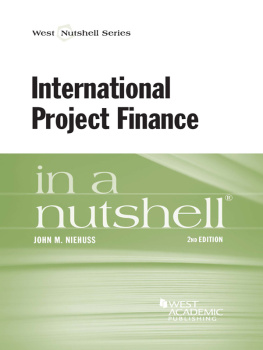
Contents
Founded in 1807, John Wiley & Sons is the oldest independent publishing company in the United States. With offices in North America, Europe, Australia, and Asia, Wiley is globally committed to developing and marketing print and electronic products and services for our customers' professional and personal knowledge and understanding.
The Wiley Finance series contains books written specifically for finance and investment professionals as well as sophisticated individual investors and their financial advisors. Book topics range from portfolio management to e-commerce, risk management, financial engineering, valuation and financial instrument analysis, as well as much more.
For a list of available titles, visit our website at www.WileyFinance.com .
Cover image: Ian Graham / iStockphoto
Cover design: Leiva-Sposato
Copyright 2013 by John D. Finnerty. All rights reserved.
Published by John Wiley & Sons, Inc., Hoboken, New Jersey.
Published simultaneously in Canada.
No part of this publication may be reproduced, stored in a retrieval system, or transmitted in any form or by any means, electronic, mechanical, photocopying, recording, scanning, or otherwise, except as permitted under Section 107 or 108 of the 1976 United States Copyright Act, without either the prior written permission of the Publisher, or authorization through payment of the appropriate per-copy fee to the Copyright Clearance Center, Inc., 222 Rosewood Drive, Danvers, MA 01923, (978) 750-8400, fax (978) 646-8600, or on the Web at www.copyright.com . Requests to the Publisher for permission should be addressed to the Permissions Department, John Wiley & Sons, Inc., 111 River Street, Hoboken, NJ 07030, (201) 748-6011, fax (201) 748-6008, or online at http://www.wiley.com/go/permissions .
Limit of Liability/Disclaimer of Warranty: While the publisher and author have used their best efforts in preparing this book, they make no representations or warranties with respect to the accuracy or completeness of the contents of this book and specifically disclaim any implied warranties of merchantability or fitness for a particular purpose. No warranty may be created or extended by sales representatives or written sales materials. The advice and strategies contained herein may not be suitable for your situation. You should consult with a professional where appropriate. Neither the publisher nor author shall be liable for any loss of profit or any other commercial damages, including but not limited to special, incidental, consequential, or other damages.
For general information on our other products and services or for technical support, please contact our Customer Care Department within the United States at (800) 762-2974, outside the United States at (317) 572-3993 or fax (317) 572-4002.
Wiley publishes in a variety of print and electronic formats and by print-on-demand. Some material included with standard print versions of this book may not be included in e-books or in print-on-demand. If this book refers to media such as a CD or DVD that is not included in the version you purchased, you may download this material at http://booksupport.wiley.com . For more information about Wiley products, visit www.wiley.com .
Library of Congress Cataloging-in-Publication Data:
Finnerty, John D.
Project financing : asset-based financial engineering / John D. Finnerty, PHD. Third edition.
pages cm. (Wiley finance series)
Includes bibliographical references and index.
ISBN 978-1-118-39410-6 (cloth); ISBN 978-1-118-42184-0 (ebk);
ISBN 978-1-118-41759-1 (ebk); ISBN 978-1-118-57219-1 (ebk)
1. Capital investments. 2. Capital investmentsCase studies. 3. CorporationsFinanceCase studies. 4. Financial engineering. I. Title.
HG4028.C4F488 2013
658.152dc23
2013007116
To my wife,
Louise Hoppe Finnerty,
and my son,
William Patrick Taylor Finnerty,
for their understanding and encouragement.
Preface
Project finance has intrigued me ever since I was introduced to it as an associate at Morgan Stanley & Co. My experience in project finance, both as an investment banker and as a professor of finance at Fordham University, has firmly convinced me of its usefulness, especially in enabling the emerging economies to unlock the value of their natural resources and build the infrastructure they need to move forward.
Project financing is a well-established technique for large capital intensive projects. Its origins can be traced to the thirteenth century when the English Crown negotiated a loan from the Frescobaldi, one of the leading merchant bankers of the period, to develop the Devon silver mines. They crafted a loan arrangement much like what we would call a production payment loan today.
A great variety of investments have since been project financed, including pipelines, refineries, electric power generating facilities, hydroelectric projects, dock facilities, mines, mineral processing facilities, toll roads, and many others. Indeed project finance experienced a resurgence in the 1980s when it was used frequently to finance cogeneration and other forms of power production. It grew in the 1990s as a means of financing projects designed to help meet the enormous infrastructure needs that exist in the developed countries and especially in the emerging markets.
I wrote the first edition of this book with both practitioners and students of finance in mind. For practitioners, project financing can provide a cost-effective means of raising funds. Sponsors should carefully consider using it whenever a project is capable of standing on its own as a separate economic entity. In this book, I describe the types of capital investments for which project financing is suitable and explain how to engineer the financing arrangements that support it. Because of project financing's enormous practical value, students of finance would be wise to learn about it so they can include it in their financing skill set.
The audience for this book includes:

Financial managers who are responsible for arranging financing for their companies' projects.

Government officials who are wondering how to finance their wish lists of infrastructure projects.

Investment bankers and commercial bankers who assist companies in raising funds for large capital intensive projects.

Accountants, consultants, lawyers, and other professionals who work in the corporate finance area and wish to keep up-to-date.

Investors who are considering committing funds to limited-purpose companies or to mutual funds that have been set up to invest in infrastructure projects in the emerging markets.

MBA students and executive MBA students studying corporate finance.

Students of finance who wish to be fully knowledgeable concerning the techniques modern financiers are using to finance large-scale projects.











 Financial managers who are responsible for arranging financing for their companies' projects.
Financial managers who are responsible for arranging financing for their companies' projects.